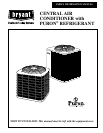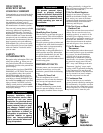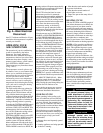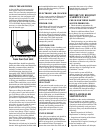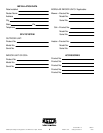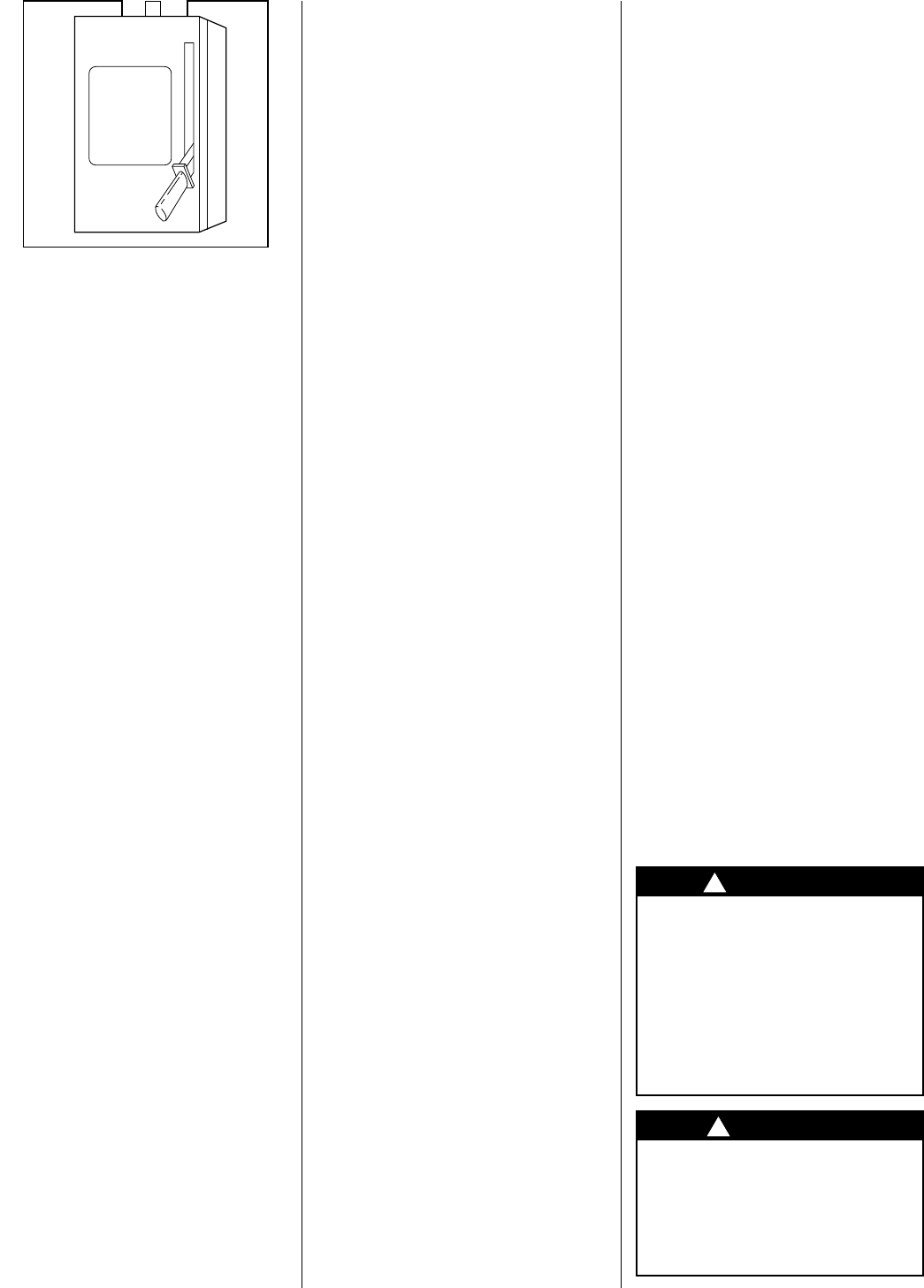
4
than 55°F without modification. If oper-
ation below this temperature is required,
consult your installer.
OPERATING YOUR
AIR CONDITIONER
The operation of your air conditioning
system is controlled by the indoor
thermostat. You simply adjust the
thermostat and it maintains the indoor
temperature at the level you select. Most
thermostats have three controls; a tem-
perature control selector, a FAN control,
and a SYSTEM or MODE control.
Thermostats may vary from those shown
in Fig. 2 and 3.
The temperature control selector can
be a button, lever, or set of buttons that
allows you to establish the degree of
temperature that you wish to maintain
for your personal comfort. Some
thermostats possess two temperature
control selectors; one for setting the
temperature desired during the cooling
cycle, and one for setting the heating
operation temperature.
The FAN control offers two options for
controlling the blower; AUTO and ON.
When set to AUTO, the blower will run
only while the thermostat operates the
cooling or heating section. When the FAN
control is set to ON, the blower will run
continuously—regardless of whether the
cooling or heating section is operating.
Typically, the SYSTEM or MODE control
on your thermostat offers the following
selections; COOL, OFF, and HEAT. Your
thermostat may also have a fourth selec-
tion, AUTO. Neither the cooling or heat-
ing section will operate when the
SYSTEM or MODE control is set to OFF.
With the SYSTEM or MODE control set
to COOL, the cooling section of your
comfort system will operate when the
indoor temperature rises above the level
that you wish to maintain. With the SYS-
TEM or MODE control set to HEAT, the
heating section will operate automatically
when the indoor temperature falls below
the level that you have selected.
The AUTO selection found on some
thermostats provides for automatic
changeover between cooling and heating
cycles. With the SYSTEM or MODE
control set to AUTO, the cooling section
will operate when the indoor temperature
rises above the thermostat cooling
temperature setting, or the heating
section will operate when the indoor
temperature drops below the thermostat
setting for the heating cycle.
Your thermostat may be PROGRAM-
MABLE or NON-PROGRAMMABLE.
A NON-PROGRAMMABLE thermo-
stat does not allow the temperature set-
tings to be varied throughout the day or
week without physically changing the
settings. A PROGRAMMABLE thermo-
stat allows various daily temperature
changes to be preset. During the winter,
for example, you may wish to set back
the temperature of your home at night,
then have the temperature return to
normal prior to waking up. The home’s
temperature can then be lowered again
during the day when no one is at home,
but again be at peak comfort level when
your family returns home. During the
summer, the opposite changes might be
programmed. When properly used, the
programming can result in energy sav-
ings on your home’s heating and cooling.
NOTE:
For 2-speed air conditioners, this
special feature is built in to protect the unit.
• 1-MINUTE TIME DELAY – When
changing speeds from low to high, or
high to low, there is a 1-minute time
delay. During the speed change delay, the
outdoor fan will continue to run.
If you wish to program your accessory
electronic indoor thermostat, refer to
thermostat Installation Instructions.
COOLING CYCLE
When operating in the cooling cycle,
your air conditioner will run until the
indoor temperature is lowered to the level
you have selected. On extremely hot
days, your air conditioner will run for
longer periods at a time and have shorter
off periods than on moderate days.
The following are typical conditions
that add extra heat and/or humidity to
your home and force your cooling unit
to work longer to keep your home
comfortable:
• Entrance doors are frequently opened
and closed.
• Laundry appliances are being operated.
• A shower is running.
• More than the usual number of people
are present in the home.
• More than the normal number of
electric lights are in use.
• Drapes are open on the sunny side of
the home.
HEATING CYCLE
With the SYSTEM or MODE control of
your indoor thermostat set to HEAT, the
heating section of your home comfort
system will operate until room tempera-
ture is raised to the level you have selected.
Of course, the heating unit will have to
operate for longer periods to maintain a
comfortable environment on cooler days
and nights than on moderate ones.
Refer to your furnace User’s Manual for
specific information on heating operation.
NOTES:
a) Two-speed air conditioners
operate for long periods of time on low
speed. This operation improves system
efficiency and your comfort through clos-
er control of temperature and humidity.
Expect longer operating cycles.
b) With two-speed air conditioners, low
and high indoor airflow settings are critical
for maintaining system comfort and effi-
ciency. Consult your installer for airflow
setting adjustments.
PERFORMING ROUTINE
MAINTENANCE
With the proper maintenance and care,
your air conditioning unit will operate
economically and dependably. Mainte-
nance can be accomplished easily by
referring to the following directions.
However, before performing mainte-
nance, consider these important safety
precautions:
WARNING
To prevent personal injury or
death disconnect all electrical
power to the air conditioner be-
fore removing access panels or
performing any maintenance.
Disconnect power to both the
indoor and outdoor units. Note:
There may be more than 1 elec-
trical disconnect switch.
CAUTION
Although special care has
been taken to minimize sharp
edges in the construction of
your unit, be extremely careful
when handling parts or reach-
ing into the unit.
!
!
Fig. 4—Main Electrical
Disconnect
MAIN
ON
OFF



